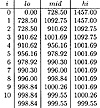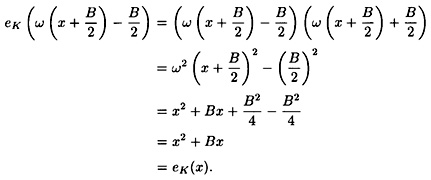Cryptography: Theory and Practice:The RSA System and Factoring
 | Cryptography: Theory and Practice by Douglas Stinson CRC Press, CRC Press LLC ISBN: 0849385210 Pub Date: 03/17/95 |
| Previous | Table of Contents | Next |
4.7 The Rabin Cryptosystem
In this section, we describe the Rabin Cryptosystem, which is computationally secure against a chosen-plaintext attack provided that the modulus n = pq cannot be factored. The system is described in Figure 4.13.

Figure 4.12 Binary search for RSA decryption
We will show that the encryption function eK is not an injection, so decryption cannot be done in an unambiguous fashion. In fact, there are four possible plaintexts that could be the encryption of any given ciphertext. More precisely, let w be one of the four square roots of 1 modulo n. Let  . Then, we can verify the following equations:
. Then, we can verify the following equations:

(Note that all arithmetic is being done in  , and division by 2 and 4 is the same as multiplication by 2-1 and 4-1 modulo n, respectively.)
, and division by 2 and 4 is the same as multiplication by 2-1 and 4-1 modulo n, respectively.)
The four plaintexts that encrypt to eK(x) are x, -x - B, ω(x + B/2) - B/2 and -ω(x + B/2) - B/2, where ω is a non-trivial square root of 1 modulo n. In general, there will be no way for Bob to distinguish which of these four possible plaintexts is the “right” plaintext, unless the plaintext contains sufficient redundancy to eliminate three of these four possible values.

Figure 4.13 Rabin Cryptosystem
Let us look at the decryption problem from Bob’s point of view. He is given a ciphertext y and wants to determine x such that

This is a quadratic equation in the unknown x. We can eliminate the linear term by making the substitution x1 = x + B/2, or equivalently, x = x1 - B/2. Then the equation becomes

or

If we define C == B2 /4 + y, then we can rewrite the congruence as

So, decryption reduces to extracting square roots modulo n. This is equivalent to solving the two congruences

and

(There are two square roots of C modulo p and two square roots modulo q. Using the Chinese remainder theorem, these can be combined to yield four solutions modulo n.) We can use Euler’s criterion to determine if C is a quadratic residue modulo p (and modulo q). In fact, C will be a quadratic residue modulo p and modulo q if encryption was performed correctly. But Euler’s criterion does not help us find the square roots of C; it yields only an answer “yes” or “no.”
When p ≡ 3 (mod 4), there is a simple formula to compute square roots of quadratic residues modulo p. Suppose C is a quadratic residue and p ≡ 3 (mod 4). Then we have that

Here we again make use of Euler’s criterion, which says that if C is a quadratic residue modulo p, then C(p-1)/2 ≡ 1 (mod p). Hence, the two square roots of 7 modulo P are ±C(p+1)/4 mod p. In a similar fashion, the two square roots of 7 modulo q are ±C(q+1)/4 mod q. It is then straightforward to obtain the four square roots x1, of C modulo n using the Chinese remainder theorem.
REMARK It is interesting that for p ≡ 1 (mod 4) there is no known polynomial-time deterministic algorithm to compute square roots of quadratic residues modulo p. There is a polynomial-time Las Vegas algorithm, however.
Once we have determined the four possible values for x1, we compute x from the equation x = x1 - B/2 to get the four possible plaintexts. This yields the decryption formula

| Previous | Table of Contents | Next |
Copyright © CRC Press LLC
EAN: 2147483647
Pages: 133